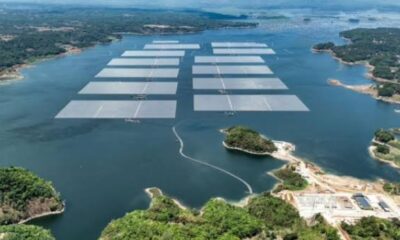Top Notable Renewable Energy Companies in Indonesia (as of Feb 20, 2024)
Defining the “top” renewable energy companies is subjective and depends on factors like installed capacity, project diversity, and innovation. However, here are 10 notable companies driving Indonesia’s renewable energy transition:
Solar Energy:
- Alva Energi: Mission: “energy for all,” focusing on remote and underserved areas.
- PT. Sumber Energi Surya Nusantara (SESNA Group): Leading solar energy company with project development, financing, and installation services.
- PT Surya Utama Nuansa (SUN Energy): Prominent player in rooftop solar market with customized solutions for homes and businesses.
- Canadian Solar Inc.: Global solar panel manufacturer with a significant presence in Indonesia.
- Trina Solar Co. Ltd.: Major solar panel manufacturer with operations in Indonesia.
Hydropower:
- PT PLN (Persero): State-owned electricity company managing a large portion of Indonesia’s hydropower capacity.
- PT Indonesia Power: Private company with a significant portfolio of hydropower plants.
Geothermal:
- PT Pertamina Geothermal Energy (PGE): Subsidiary of Pertamina, focusing on geothermal development.
- Star Energy Geothermal Pte. Ltd.: Singapore-based company with geothermal projects in Indonesia.
Other Renewables:
- Lumare Energi: Developing innovative Ocean Thermal Energy Conversion (OTEC) technology for clean and reliable power.
Remember: This list is not exhaustive, and the landscape of Indonesia’s renewable energy sector is constantly evolving. Consider your specific needs and priorities when choosing a renewable energy solution.
KPIs for Top Renewable Energy Companies in Indonesia
Determining the best KPIs for different companies can be complex, as each might prioritize different aspects. However, here are some relevant KPIs you can consider for the listed companies, categorized by their specific renewable energy focus:
Solar Energy:
- Total installed capacity (MW): Measures the overall contribution to generation capacity.
- Number of projects completed: Shows active development and market reach.
- Average cost per kWh generated: Reflects affordability and competitiveness.
- Rooftop solar market share: Relevant for companies like SUN Energy.
- Innovation in technology or solutions: Measures commitment to advancement.
Hydropower:
- Total installed capacity (MW): Similar to solar energy, measures generation contribution.
- Average electricity generation (GWh per year): Indicates operational efficiency.
- Contribution to grid stability and peak demand management.
- Environmental impact, including dam management and ecosystem preservation.
Geothermal:
- Total installed capacity (MW): Measures generation contribution.
- Number of active wells and geothermal fields: Shows resource utilization and development.
- Average electricity generation (GWh per year): Reflects operational efficiency.
- Exploration success rate and new field development progress: Measures growth potential.
- Carbon footprint and greenhouse gas emission reduction achieved.
Other Renewables (Lumare Energi):
- Pilot project progress and demonstration of OTEC technology effectiveness.
- Cost competitiveness compared to established renewables.
- Investment secured for scaling up deployment.
- Environmental impact and potential for marine biodiversity conservation.
Additional KPIs:
- Safety record and accident rate.
- Job creation and community development initiatives.
- Transparency and corporate governance practices.
- Customer satisfaction and service quality.
Data Sources:
- Company websites and annual reports.
- Indonesian Ministry of Energy and Mineral Resources (ESDM) data.
- Industry publications and reports.
Remember: This is not an exhaustive list, and the specific KPIs chosen will depend on your individual interests and priorities. You can further customize these KPIs to fit your specific research goals and questions.
https://www.exaputra.com/2024/02/top-notable-renewable-energy-companies.html
Renewable Energy
Deer Hunters and Gun Deaths
A couple of points:
Actually, there are 11.4 million deer hunters, 4.6 million use archery and 6.8 million use guns. It just takes a second to look this up, and doing so prevents one from spreading malicious lies.
Hunters don’t use not assault weapons, which are almost always chosen by mass murderers. No one with any sense objects to rifles being sold to hunters.
Renewable Energy
With Trump, It Gets Worse by the Day
With each passing day, Trump’s rhetoric reveals to an even greater degree his cruelty, his vindictiveness, and most of all, his lack of understanding of the U.S. Constitution. The only thing he has on his side is his capacity to mirror the hate and ignorance of his MAGA base.
We used to be proud of our country.
Renewable Energy
How Japan (Doesn’t) Fight Fires
 I’ve been to Japan. They’re sharp people.
I’ve been to Japan. They’re sharp people.
At the very least, they don’t have people stupid enough to indiscriminately shoot water all over a village because of a kitchen fire.
-
Climate Change3 months ago
Guest post: Why China is still building new coal – and when it might stop
-
Greenhouse Gases3 months ago
Guest post: Why China is still building new coal – and when it might stop
-
Climate Change2 years ago
Spanish-language misinformation on renewable energy spreads online, report shows
-

 Greenhouse Gases1 year ago
Greenhouse Gases1 year ago嘉宾来稿:满足中国增长的用电需求 光伏加储能“比新建煤电更实惠”
-
Climate Change Videos2 years ago
The toxic gas flares fuelling Nigeria’s climate change – BBC News
-

 Climate Change1 year ago
Climate Change1 year ago嘉宾来稿:满足中国增长的用电需求 光伏加储能“比新建煤电更实惠”
-

 Carbon Footprint2 years ago
Carbon Footprint2 years agoUS SEC’s Climate Disclosure Rules Spur Renewed Interest in Carbon Credits
-
Renewable Energy4 months ago
US Grid Strain, Possible Allete Sale













